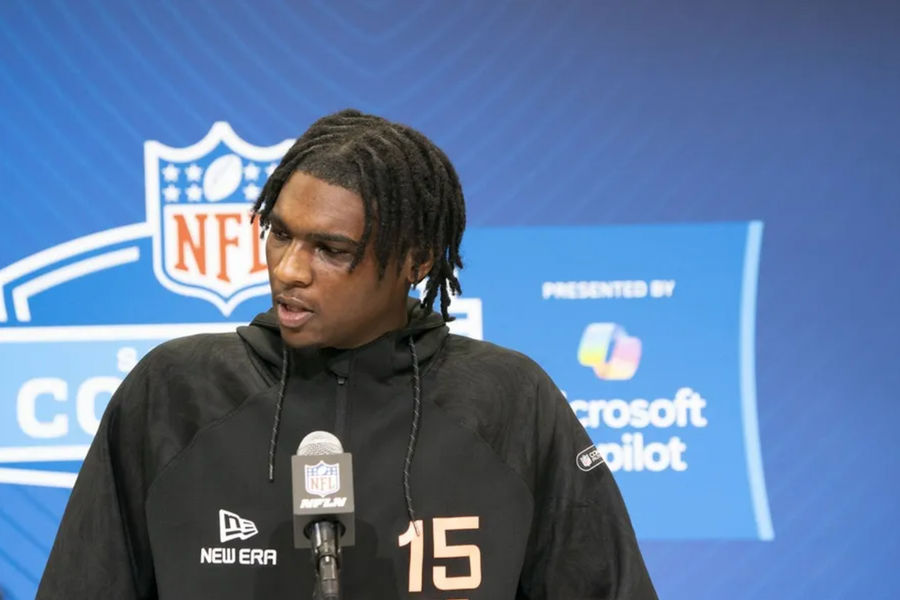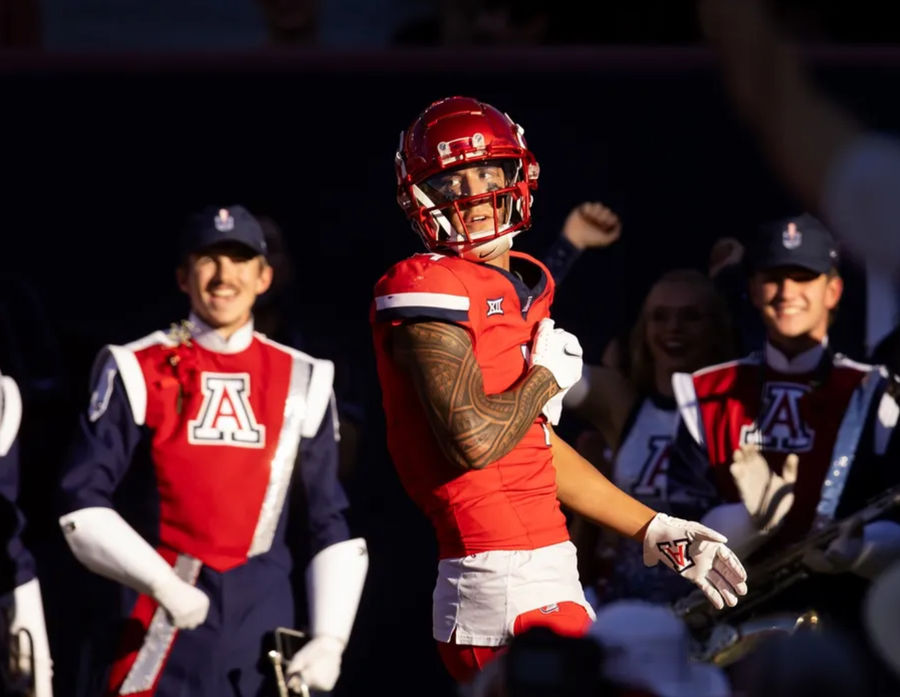 Feb 28, 2025; Indianapolis, IN, USA;Miami quarterback Cam Ward (QB15) talks to the press during the 2025 NFL Combine at Indiana Convention Center. Mandatory Credit: Stephanie Amador Blondet-Imagn Images
Feb 28, 2025; Indianapolis, IN, USA;Miami quarterback Cam Ward (QB15) talks to the press during the 2025 NFL Combine at Indiana Convention Center. Mandatory Credit: Stephanie Amador Blondet-Imagn Images There was an obvious floor for 2024 No. 1 overall pick Caleb Williams, and a ceiling most pegged to be approaching All-Pro level — if he could put all the mental, physical and emotional parts of the quarterback position together.
Even if his growth was stunted or he fell into a situation where coaching put him in a box where he didn’t belong, the floor — meaning what Williams would become as a pro quarterback at his worst — was pretty solid as a competitive NFL starter.
Where the delta lies between the floor and the ceiling among the top NFL Draft prospects in the 2025 class paints a starkly different picture. It’s not that Miami quarterback Cam Ward and Williams are diametrically opposed on the scouting spectrum. Their measurables aren’t exact carbon copies, but Ward wins with competitive verve, mental acuity and calculated risk-taking. It’s those risks that lead to comparisons to the likes of Aaron Rodgers and Patrick Mahomes.
Williams has the type of talent to win consistently even when the chips are down. He proved it by keeping the Bears in many games during his rookie season despite a stumblebum offensive line, challenging Rodgers’ record for completions without an interception over the second half of the 2024 season.
Ward might not be an instant hit à la C.J. Stroud (Texans) or Jayden Daniels (Commanders), but we like his chances as the peak passer in a class with nothing behind him but boom-or-bust options. It’s the reason Shedeur Sanders (Colorado), Jalen Milroe (Alabama), Jaxson Dart (Ole Miss), Tyler Shough (Louisville), Will Howard (Ohio State) and Kyle McCord (Syracuse) are viewed on a tier or two down the board from Ward. Do they have winning traits? Yes. Are they NFL-ready quarterbacks? Not exactly.
Of the group, Milroe offers the most exciting combination of athletic ability, production and potential. He also has some of the worst moments on game film, with decision-making that you’d expect from a running back playing the position. What evaluators love about Milroe compared to Sanders is not just straight-line, track-star speed. He’s infinitely coachable, works tirelessly and holds himself accountable over others. His expectations are steep and his process for preparation and daily development rings reminiscent of another overlooked former Alabama quarterback who just hoisted the Lombardi Trophy.
Where is the floor for Milroe? It could be too low for comfort for some teams because of their belief he’ll need more than a year to watch and learn. If I’m the Steelers or Giants, Browns or Rams, with a semi-settled situation at the position but an obvious need for a quarterback of the future, Milroe is the gamble I’m taking on Friday.
Quarterbacks aren’t the only boom-or-bust varietals in this draft.
If there’s one player I’m convinced is “safe” among the consistently bandied names in the top 10, it’s Colorado’s Travis Hunter. It’s no stretch to say there’s risk in drafting him No. 2 or No. 3. At 185 pounds with high miles on his wheels, the worry about his durability and longevity shouldn’t be hushed entirely. But his playmaking gene is undeniable. As a cornerback and wide receiver — or some combination therein — Hunter immediately makes any team better. Explosive game changers are unicorns.
At every other position, the top-ranked player on the Field Level Media board has a big potential bust factor. They could also be great.
No. 1-ranked RB Ashton Jeanty
 Dec 31, 2024; Glendale, AZ, USA; Boise State Broncos running back Ashton Jeanty (2) reacts after the game against the Penn State Nittany Lions in the Fiesta Bowl at State Farm Stadium. Mandatory Credit: Mark J. Rebilas-Imagn Images
Dec 31, 2024; Glendale, AZ, USA; Boise State Broncos running back Ashton Jeanty (2) reacts after the game against the Penn State Nittany Lions in the Fiesta Bowl at State Farm Stadium. Mandatory Credit: Mark J. Rebilas-Imagn Images Love the Boise State running back and everything he stands for, but when you discuss a running back in the top five, peek back at the history of steep fallout at the position. There are far more fumbles than touchdowns. Who didn’t think Trent Richardson (No. 3 overall) was headed for a level of greatness out of Alabama? The opportunity cost of drafting a running back here is the biggest factor to evaluators. That’s because history points to huge success stories far later in the draft, and this is historically one of the deepest crops of runners in decades.
Speaking of Alabama backs, Derrick Henry was the 45th pick in 2016. That’s 41 picks behind Ezekiel Elliott (No. 4, Cowboys). Had Dallas considered its pressing need at cornerback and drafted Jalen Ramsey at No. 4 (he went fifth to Jacksonville), Henry was still available when the Cowboys took linebacker Jaylon Smith 34th overall.
No. 1-ranked OLB Jalon Walker (Georgia)
He’s packed with potential. Production? He had 11.5 total sacks over the past two seasons and has 11 career starts. We’re rolling the dice on his potential and upside based on length and burst, but admit his instincts aren’t quite there.
No. 1-ranked WR Tetairoa McMillan (Arizona)
 Nov 30, 2024; Tucson, Arizona, USA; Arizona Wildcats wide receiver Tetairoa McMillan (4) celebrates a touchdown against the Arizona State Sun Devils in the second half during the Territorial Cup at Arizona Stadium. Mandatory Credit: Mark J. Rebilas-Imagn Images
Nov 30, 2024; Tucson, Arizona, USA; Arizona Wildcats wide receiver Tetairoa McMillan (4) celebrates a touchdown against the Arizona State Sun Devils in the second half during the Territorial Cup at Arizona Stadium. Mandatory Credit: Mark J. Rebilas-Imagn Images He’s far taller — over 6-foot-4 — than the prototype but rail thin, and some aren’t convinced of his long speed. He produced huge numbers at Arizona in a fastbreak-on-grass offense and has highlights for days. But rate your confidence in all of this translating to the NFL game. Are we at 75 percent certainty? I’m closer to 45.
No. 1-ranked OT Will Campbell (LSU)
Some consider Campbell a “safe” pick because he could be situated as a guard if he can’t hold the edge with his shorter-than-ideal arms. Patriots coach Mike Vrabel says Campbell is a left tackle all day because he blocked SEC pass rushers. As much as we appreciate the SEC, it’s not the NFL.
Campbell’s wingspan of 77 3/8 inches, taken at the NFL Scouting Combine in February, was the lowest for any offensive tackle at the event since 2011. If I’m drafting a guard, that’s workable. But I can also find a top-ranked guard at the bottom of the first round. I’m uncomfortably anxious as the top decision-maker in New England betting the success of 2024 No. 3 pick Drake Maye and the Patriots’ offense on Campbell’s length not being too great of a risk.

